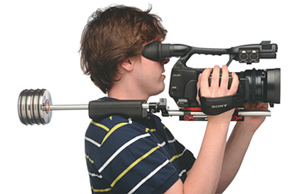Taking a Trip to the Aftermarket

Who says miracles don't happen? I'm a big fan of the miraculous… especially the modern day techno-miracle that lets tiny, relatively inexpensive tapeless cameras make astounding high-def pictures.
Now, I know full well that, empirically speaking, these little 4:1:1-colorspace wonders can't hold a candle to their 4:2:2 siblings; and I agree that bigger imagers and better lenses pretty much guarantee better performance. But back down here on planet earth, I look at the monitor, and I can't help but think that "the little camera" makes pretty wonderful pictures. And that's without even looking at the tiny price tags.
It seems that more than a few shooters agree with me. "Little cameras," sporting tape drives or tapeless, are flying off the shelves … JVC's GY-HM700, the Canon XL-H1S, Sony PMWEX1 and PMWEX3, and Panasonic HPX170.
Sometimes, they're purchased as lower-cost companions to closely matched "big cameras," like a Sony PDW-700 or Panasonic AJ HPX3000. Other times, though, they're the main event—the single money-earning tool of a stringer, shooter or production company.
Most of the purchasers understand the inherent tradeoffs of the little camera, even beyond bit depth and lensing. For many, it's an odd ergonomic form to use on an everyday basis… a little like carrying a 4-pound pot roast on the end of a dinner fork. And ever since the first mini-DV cameras sported butt-mounted viewfinders, it's been a chore to both see the image and control the camera at the same time; LCD flip panels have helped, but their marginal quality leaves you clueless about little things like focus and exposure.
There is another less-mentioned disadvantage, too—cosmetics. To your "civilian" client, there's not much that distinguishes your $8,000 baby from an $800 consumer model. Consider its petite size, consumer-ish styling and stern-mounted viewfinder; and then try explaining away that extra cost to someone whose biggest imaging investment to date has been a pink four-megapixel toy on Woot.com.
So those are the challenges—add missing or reduced functionality where needed, sort out the ergonomics, and make a great camera into an uber-cool camera. It's time for a trip to… The Aftermarket.
ACCESSORIZE OR DIE
Born out of cleverness and entrepreneurial ambition, the Aftermarket for our little cameras is a thriving web of developers and manufacturers who are loaded not only with bright ideas, but with the ability to manufacture and deliver relatively small quantities of narrowly-focused, limited-appeal products. Sounds impossible, no? But as a trip to the 2009 NAB Show revealed, it's possible; it's real; and it's thriving.
Despite the lure of hundreds of other exhibitors, I found myself drawn repeatedly to the booths that showcased enabling technologies for "the little camera." Some were relatively older companies, whose insight had led them to extend their gaze downward toward this seemingly smaller market.
Looking to power your rig all day? Anton Bauer had that and more. Camera cases, and even backpacks, designed by and for small-camera shooters? Perennial favorite PortaBrace showed some really innovative stuff… and in more than one color, too.
In many cases, though, the exhibitors' names would have been unfamiliar a mere five years ago. Redrock Micro, which designs and manufactures a complete line of small-camera support gear, generated some real buzz when they first launched an optical adapter, which permitted the use of cinema prime lenses with one-piece, fixed-lens cameras. Today, they're regarded as a major developer of feature-grade camera gear… not bad from a standing start in 2004.
One repeat destination for me was Zacuto's display of camera support systems. Their full catalog reads like a Chinese menu of mix-and-match options, all designed to turn the little camera into a powerful—and good-looking—rig.

Zacuto camera support kit for the Sony EX1 Start with a basic twin-rail sled... add a matte box and follow-focus options, twin front grips, and brackets for FireWire drives and batteries… plus a mounting arm for your small HD monitor. Best of all, one configuration includes a shoulder mount aligned so you really can look into that rear-positioned viewfinder… miraculous.
BEFORE THE AFTERMARKET
Sometimes, the Aftermarket can be found without leaving the manufacturer's own catalog. Some manufacturers, such as Panasonic, will package Anton Bauer batteries, Varizoom controls and FireStore drives along with your camera—a one-stop shopping experience, which leasing brokers love.
Sony's offerings in support of its own XDCAM-EX family include several free software applications, as well as interchangeable lenses for the EX-3 camera. The clincher: the NIPROS/1 system, an "accessory," which actually costs twice as much as the camera itself. Still, the NIPROS setup is a bargain, providing a complete soup-to-nuts camera chain in a studio/remote configuration including viewfinder, lens controls, headset, and, most importantly, standardized SMPTE fiber connections between the camera and its control base. NIPROS' total cost is a fraction of that of a Triax-based standard-def studio/remote setup.
The idea of "the little camera" in full studio dress may border on the surreal; but that's the real story here. We all seem to agree that small-camera technology delivers not merely "acceptable" results, but really attractive pictures—why not take advantage of the cost savings and smaller form factor, and send them up to the majors?
But before the little cameras can make that journey, they need a side trip—a trip to the Aftermarket.
Walter Schoenknecht is a partner at Midnight Media Group Inc., a New York-area digital production facility. You can reach him via e-mail atwalter@mmgi.tv.
The professional video industry's #1 source for news, trends and product and tech information. Sign up below.
